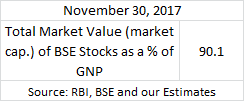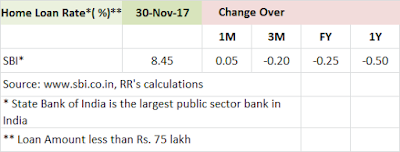Please see my blog of July 9, 2014 for the original note on using TMV/GNP ratio to gauge whether the market is cheap or expensive, and my nonthly blogs on this subject.
Saturday, 30 December 2017
Friday, 15 December 2017
Fourth and Fifth Bi-monthly Monetary Policy Statements
Monetary Policy 2017-18
In the last two statements - October 4 and December 6 - RBI has continued with the repo rate at 6%. This is not surprising given RBI's thinking on the subject.
Let's look at the two key macro variables - growth and inflation.
RBI marked down the growth rate for the year, 2017-18, from 7.3% to 6.7% in the October statement, and has retained this number in last week's statement. RBI's inflation projection was raised in the second half of the year from 4-4.5% to 4.2-4.6% in October; this has been marginally raised last week to 4.3-4.7%.
RBI's 2017-18 growth forecast is based on 7% in Q3 and 7.8% in Q4.
Inflation has trended higher since June in line with the RBI's expectations. After the statement on Dec 6, November CPI number came in at 4.88%. This is slightly outside the range set out by the RBI.
Please see my earlier bogs on the subject.
In the last two statements - October 4 and December 6 - RBI has continued with the repo rate at 6%. This is not surprising given RBI's thinking on the subject.
Let's look at the two key macro variables - growth and inflation.
RBI marked down the growth rate for the year, 2017-18, from 7.3% to 6.7% in the October statement, and has retained this number in last week's statement. RBI's inflation projection was raised in the second half of the year from 4-4.5% to 4.2-4.6% in October; this has been marginally raised last week to 4.3-4.7%.
RBI's 2017-18 growth forecast is based on 7% in Q3 and 7.8% in Q4.
Inflation has trended higher since June in line with the RBI's expectations. After the statement on Dec 6, November CPI number came in at 4.88%. This is slightly outside the range set out by the RBI.
Please see my earlier bogs on the subject.
Wednesday, 13 December 2017
Sunday, 3 December 2017
Monitoring the Bull Market in Indian Stocks: Update as of November 2017
According to our estimate, market cap. to GNP ratio has reached the highest level since the Modi government came to power.
Please see my blog of July 9, 2014 for the original note on using TMV/GNP ratio to gauge whether the market is cheap or expensive.
Saturday, 2 December 2017
Tuesday, 21 November 2017
Friday, 3 November 2017
Monitoring the Bull Market in Indian Stocks: Update as of October 2017
Indian Stock Market Watch
Our estimates show that market capitalisation to GNP is at highest level since Narendra Modi came to power as Prime Minister.
Our estimates show that market capitalisation to GNP is at highest level since Narendra Modi came to power as Prime Minister.
Please see my blog of July 9, 2014 for the original note on using TMV/GNP ratio to gauge whether the market is cheap or expensive.
India Market Map: A year (well, almost) after demonetisation
Foreign Exchange
The confidence in the rupee remains strong: stronger against the U.S. dollar
and Japanese Yen but weaker against the Euro and Pound Sterling. Against a
basket of 36 currencies, as of end September (data as of end October is not still available), the rupee was stronger by 2.5% over the preceding eleven months.
Indian equities have put in a super performance – the
benchmark Sensex is up by more than 20%! Although corporate earnings have been
weak on the back of a significant slowdown in the economy, equities have been the best performing
asset class. Equities generally factor in expectations of the future, so it
seems that the equities market is projecting that demonetisation, GST, and
various other measures of the government are going to be net positive for the
long term growth of the economy.
The picture on bonds is interesting. Bond yields have fallen
up to 3 years, but risen slightly from 5 to 10 years – so that the yield curve
has steepened. This seems to support the view from the equities market that the
long term growth of the economy has not been jeopardised by demonetisation and
GST. On balance, the bond market has returned a positive return over the last
year.
Gold has generated a negative return as a result of the
stronger Rupee (against the U.S. dollar).
RBI continued with its accommodative monetary policy
post-demonetisation but then shifted gear to a neutral stance in Fenruary this year.
SBI and ICICI Bank – the
largest in the public and private sectors – reduced deposit rates, but unlike
the government bond market, more in long term deposits than in short term
deposits. Significantly, both banks reduced their S.B. account rate by 0.5%, the
first such change since deregulation in 2011.
There has been a significant reduction in SBI's rate.
Real Estate
Monday, 23 October 2017
Subscribe to:
Comments (Atom)

















































